This year, hopeful entrepreneurs will list thousands of projects — books, films, drones, watches, board games, smart toothbrushes — on Kickstarter.

Here, they’ll vie to bypass traditional fundraising models, collect cash directly from the general public, and bring their products to market as autonomous operators. But this strategy won’t work out for everyone.
What exactly is the success rate on such platforms? Which types of products are the most successful? Which are the least successful? And how much money, on average, do creators raise?
To answer these questions (and more), we analyzed publicly available Kickstarter data from 2009 to 2019. (A warning to the data-wary: Brace yourself for lots of charts.)
The big picture
While there are many crowdfunding platforms for aspiring self-starters, Kickstarter is the largest, most popular, and longest-standing.
Launched in 2009, it aims to ‘democratize’ fundraising: Instead of getting a loan from a bank or groveling for VC dollars, a creator can post her “project” (a tech product, book, film, etc.) to the platform, set a monetary goal, and raise money from the general public (“backers”) to pursue it.
Kickstarter is an “all-or-nothing” platform, which means that if a creator only keeps the money if her goal is successfully met.
Since its inception, the site has hosted 433k projects Here’s a look at how these projects break down by category:
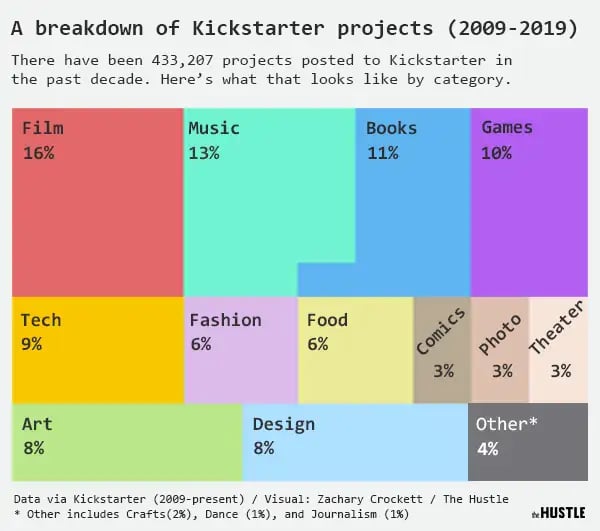
A major chunk of Kickstarter projects (40%) are films, music projects, and books. This makes sense: Kickstarter was founded by a trio of Burning Man enthusiasts as a way for creative types and artists to raise money.
Tech and design (which frequently overlap, as many tech projects are categorized under “product design”) make up 17%, and games clock in at 10%.
Among all projects, about 36.6% succeed in meeting their goal, and 63% fail. But these rates vary widely by category.
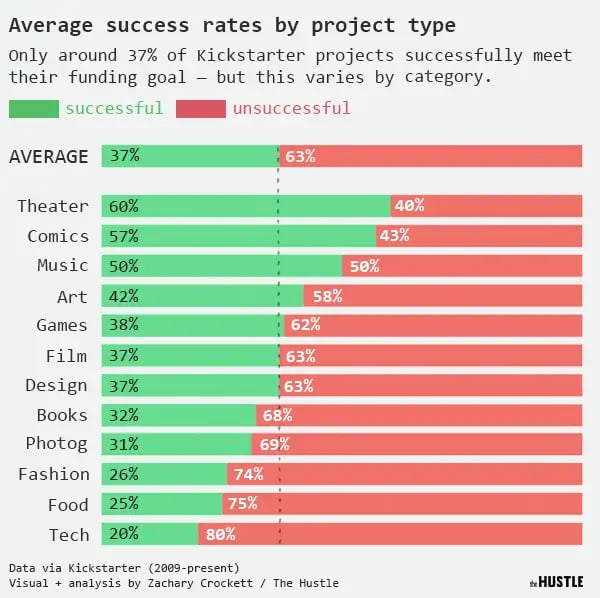
Four categories — theater (60%), comics (57%), music (50%), and art (42%) — far outpace the average success rate, while tech (20%) lags far behind it.
The “all-or-nothing” nature of Kickstarter (only being permitted to keep funds if you meet the goal) seems to be a bit prohibitive for projects that require larger budgets (e.g. tech and food trucks).
When smaller is better
To better understand why tech projects are less likely to succeed on Kickstarter, we wanted to get a sense for how much money creators typically ask for (i.e. the goals they set). So, we turned to a wonderful analysis put together by Adebola Lamidi of the ‘Towards Data Science’ blog.
Overall, the average successful project has a goal that is nearly 50% lower than the average unsuccessful project.
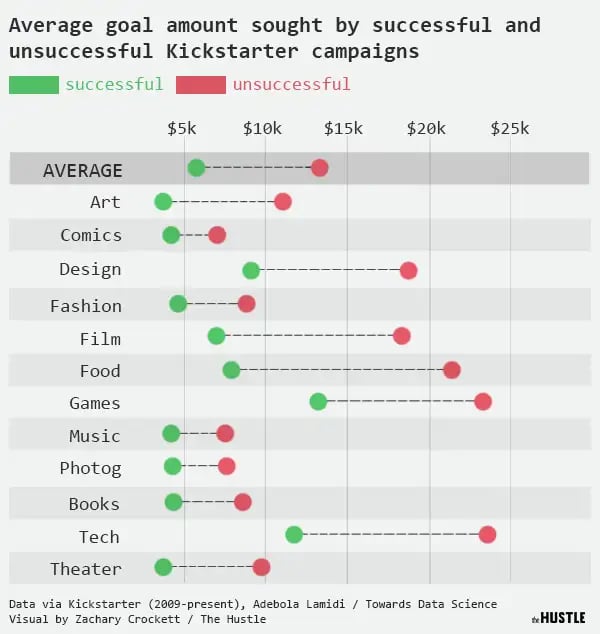
The average goal among successful projects is $6.1K, compared to $13.7k for unsuccessful projects. In every category across the board, successful projects have far lower average goals.
But let’s take a closer look at how much the successful projects — those green dots above — actually raise.
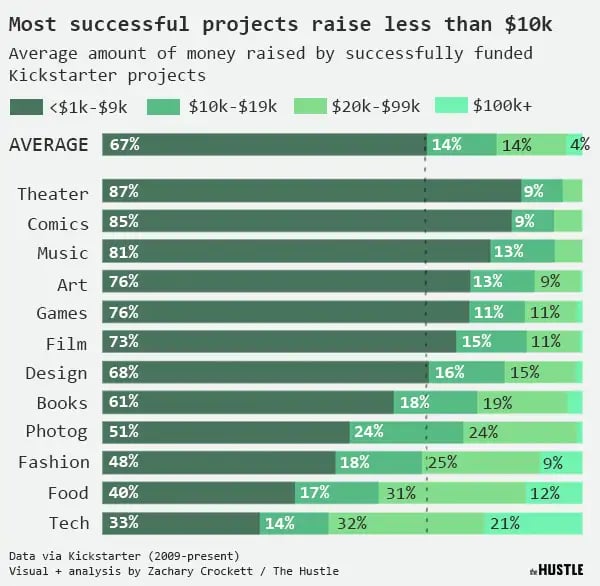
Thanks to the occasional viral product we read about in the news, like the Pebble watch or Exploding Kittens, we’ve developed the idea that Kickstarter routinely breeds multi-million dollar mega-hits.
In truth, the vast majority of successful projects — some 67% —raise less than $10k.
On the flip side, unsuccessful projects (which typically have larger goals) don’t get very far: 2 out of 10 fail to raise a single penny, and another 6 out of 10 can’t crack 20% of their goal amount.

This gives us a clear picture of what types of projects succeed and fail and suggests that realistic goal setting plays a role in the outcome.
But percentages don’t tell the full story. To really understand what drives these trends, we have to take a deeper look at the money these projects are bringing in.
How much money do projects raise?
The most popular categories on Kickstarter (film, music, books) are not the biggest money makers.
That title goes to the aforementioned big-goal goliaths: Games (video games, gaming hardware, tabletop games), design (product design), and technology (wearables, gadgets, 3D printing).
Let’s parse out these categories by total funds raised rather than total projects.
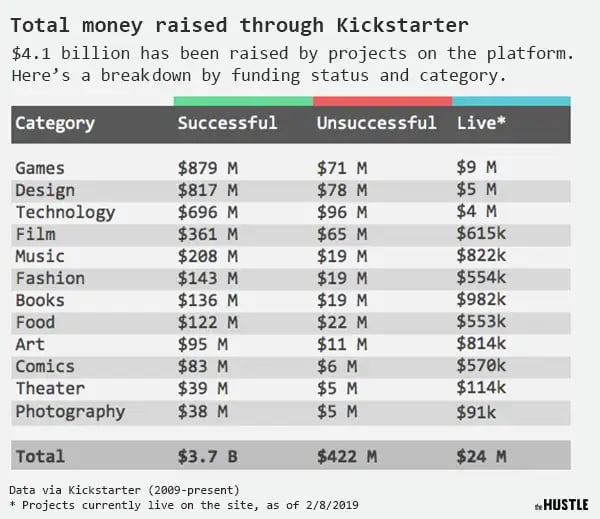
Collectively, all projects — successful, unsuccessful, and live (projects currently in the fundraising phase) have raised $4.1B.
Games make up the largest portion of this at nearly $900m, closely followed by design and tech (which, as stated, frequently overlap on the site). Here, the more artistic categories (photography, theater, art, books) dwell at the bottom.
Breaking this down even further, we can get a glimpse at how much the average individual project raises by category.
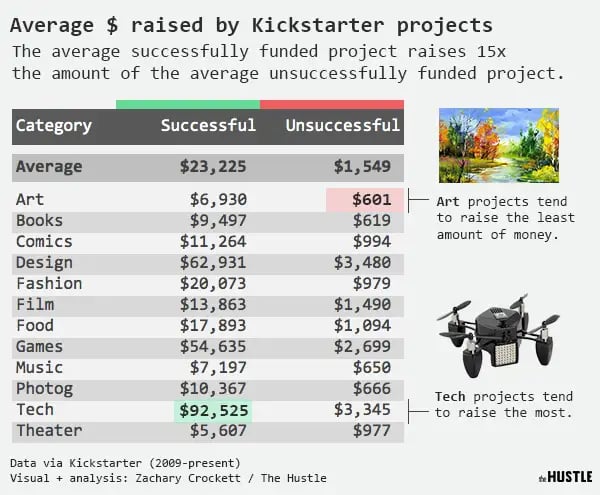
Across all categories, the average successful project on Kickstarter raises $23k, while the average unsuccessful project attracts $1.5k — about 15x less.
When the big-money categories (games, design, tech) succeed, they succeed bigly: The average successful tech project rakes in $92k, compared to the $5.6k average theater victory.
The most successful projects in history
Lastly, we decided to manually collect and analyze the 100 most-funded projects in history (all of which secured $5m+), looking for trends across categories and donation amounts. Is there a unifying thread in their success?
First off, the list is overwhelmingly populated by games — 47, to be exact.
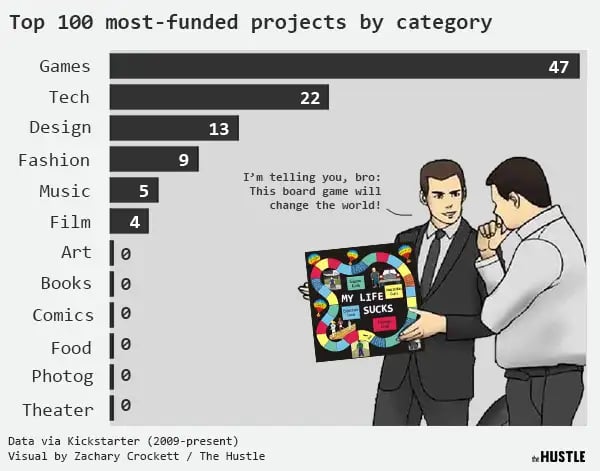
Together, tech, games, and design — the 3 most-funded categories on the site — make up 82% of the 100 most-funded individual projects.
Meanwhile, art, books, comics, food, photography, and theater (which have higher success rates overall, but lower goals) don’t even make the cut.
Funding comes in many shapes and forms: Some projects in the top 100 offered an extremely expensive product and had less than 1k backers; others had more affordable products and attracted enough backers to populate a small town.
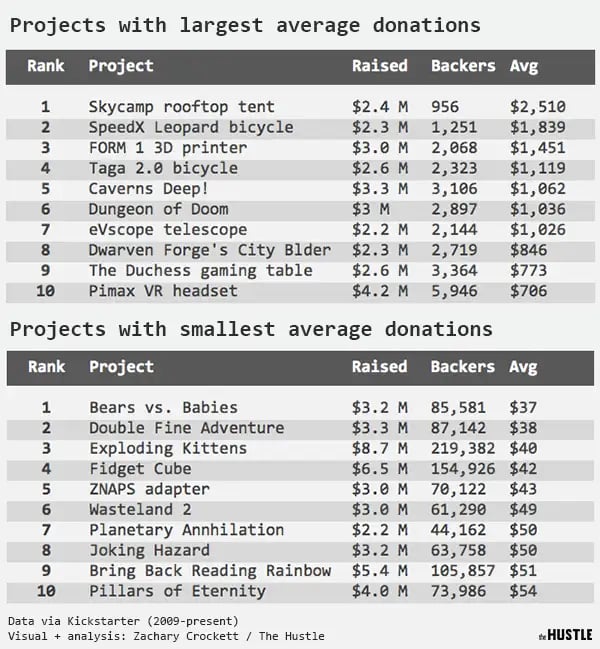
The Skycamp rooftop tent, for instance, only had 956 backers — but most of them threw down more than $2k a pop for an “early bird” version of the product. Conversely, the game Exploding Kittens raised far less but convinced 219k people to shell out.
Lastly, let’s contextualize all of this by looking at the full list of the 100 most-funded projects in Kickstarter history. (I’ve also shared this data in a Google Sheet here).

If you’re looking to fund an extremely ambitious product on Kickstarter, you should be aware that raising big cash on the platform is rare: Of 433k total projects, only these 25 managed to secure $5m+ — and in some cases, this wasn’t even enough money to cover production costs.
The Coolest Cooler (ranked #2) raised $13.3m in 2014. But 5 years later, it still hasn’t delivered units to some of its backers. “I occasionally get emails from them promising a delivery, but it has been years now and no [cooler],” Valerie Outfin, an early backer, told me. “It makes me sick.”
Similarly, the ZANO drone (ranked #39) raised £2.3m from 12k backers and only ended up delivering 600 “partially functional” prodcuts before filing for bankruptcy.
How do I increase my chances?
This data reminds us that smaller goals are often better — and that Kickstarter probably isn’t the right route for you if you need to raise more than $100k. There are, however, some simple things you can do to increase your chances of raising money at any funding level on the platform:
- Keep your copy short, sweet, and crisp: The average successful campaign has a description of 465 words.
- Always include a high-quality video: Projects with a video are 105% more likely to meet their goal.
- Touch in with your backers constantly: Creators who update their backers every 5 days see a 3x increase in contributions.
And If you do succeed, don’t be a cooler douche — deliver the goods.

